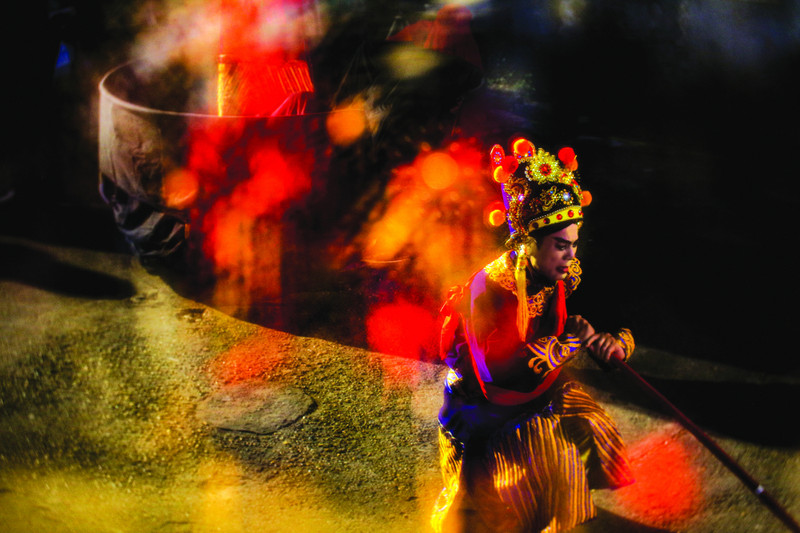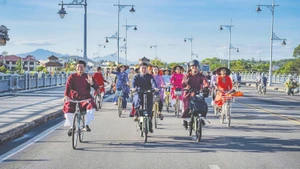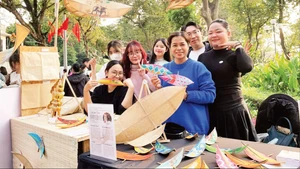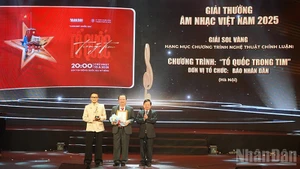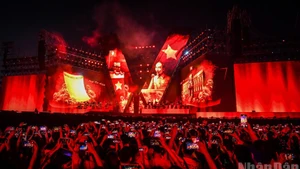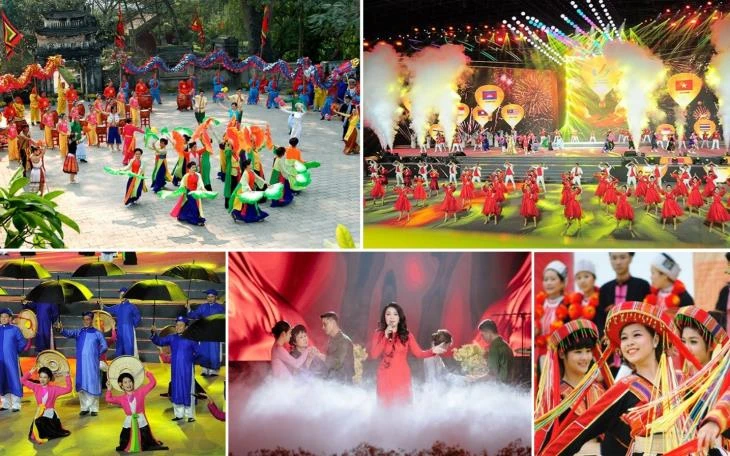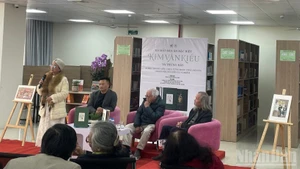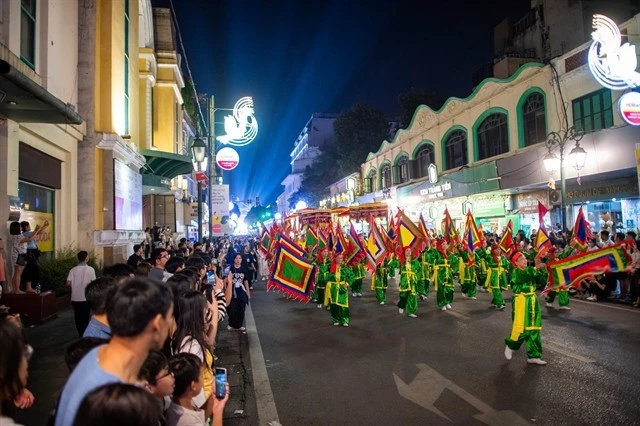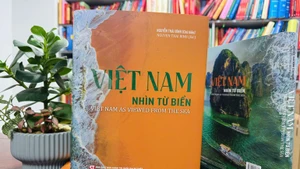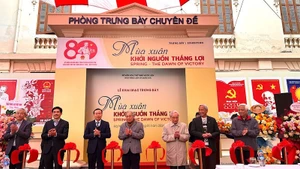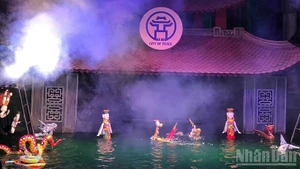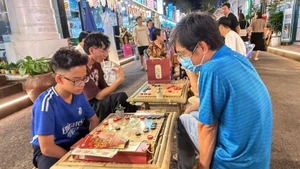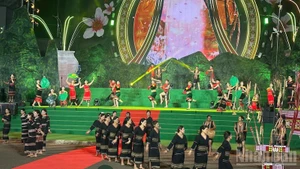Combining traditional and contemporary art
Nguyen Quoc Hoang Anh, born in 1990, is a young person who has a passion for practising culture and art and has been appreciated for many projects combining traditional and contemporary art. He launched an art platform named ‘Len Ngan’ as a multilingual cultural, artistic and creative venue, to safeguard and promote indigenous knowledge and arts.
With the mission to honour traditional art and the diversity of indigenous culture, Nguyen Quoc Hoang Anh and his team have implemented many traditional art projects, imbued with contemporary and experimental elements.
A prominent project among them is the ‘Son Hau’ (Beyond the Mountain) play, which was introduced to the public at the Van Chuong collective area, in Dong Da district, Hanoi, at the end of 2020.
‘Son Hau’ is a contemporary performance inspired by ‘Tuong’ (Vietnamese classical drama). The show features content that reminds people in the present life about issues that have never been old: morality, brotherhood, or good values of patriotism. All are expressed in a new language, both in content, images and music, bringing an attractive and distinctive breath to ‘Tuong’.
In a public stage featuring the sound of both traditional drum and electronic music, the coordination between director Ha Nguyen Long, music producer Nguyen Quoc Hoang Anh, and artists from the Vietnam Tuong Theatre created a fresh space to honour ‘tuong’, all while bringing the audience closer to the traditional art form.
 |
| Nguyen Quoc Hoang Anh has been appreciated for many projects combining traditional and contemporary art (Photo: phunuonline.com.vn) |
Following the success of ‘Son Hau’, Nguyen Quoc Hoang Anh introduced a music project entitled ‘Am – Thanh Sac – Mau’ (Sound-Beauty-Colour), with the participation of graffiti artist Cyril Kongo. Under the project, performing arts, graffiti arts, traditional Vietnamese instruments and Western instruments and music genres such as trumpet, hip hop, and jazz, are brought together to create a connection between the East and the West.
Few people know that Nguyen Quoc Hoang Anh used to not be very knowledgeable in traditional music and performing arts. Hoang Anh was a student who majored in classical music at the Military University of Culture and Arts. Hoang Anh grew up in the period when classical music, jazz, and hip hop were widely introduced and became gradually popular in Vietnam, making young people like him feel vague about traditional music.
However, while visioning his future, Hoang Anh realised that his career must be deeply rooted in the country’s culture. Given this, Hoang Anh took time to learn more about ‘ca tru’ (ceremonial singing), ‘chau van’ (spiritual singing), ‘cheo’ (traditional opera), and ‘tuong’ (classical drama).
With his unique creative thinking, Hoang Anh has implemented projects that combine traditional art with contemporary art to tell new stories about heritage, as well as folklore culture by utilising materials from sound, music, and performance.
As a multidisciplinary artist, Hoang Anh has taken on many roles such as curator, director, and music producer, Hoang Anh has strived to connect indigenous culture and traditional Vietnamese artistic heritage with contemporary art.
Utilising and honouring traditional values
 |
| Musician Nguyen Xuan Son (L) is one of the few contemporary musicians who has developed a solid background in traditional Vietnamese art and indigenous culture. (Photo: hanoigrapevine.com) |
Born into a family with a rich musical tradition, musician Nguyen Xuan Son (stage name SonX) is one of the few contemporary musicians who has developed a solid background in traditional Vietnamese art and indigenous culture. Studying traditional musical instruments under the instructions of percussion masters such as Bui Trong Dang, Nguyen Dac Han, and Do Tung, Nguyen Xuan Son graduated with a major in music from the Hanoi Academy of Theatre and Cinema.
Son's musical compositions are inspired by traditional Vietnamese music blended with contemporary colours.
Son has coordinated with choreographer Ea Sola Thuy in composing music for her dances such as ‘Drought and the Rain’, ‘Field of Music’, and ‘Praying’. In these projects, Nguyen Xuan Son shows many forms of expression such as performance, video art, sound installation, and contemporary dance stage.
Creativity and an open and multidimensional approach to tradition have helped young people further develop their national cultural heritage, motivating them to connect traditional cultural heritage with contemporary values.
Dr. Lu Thi Thanh Le, lecturer at the School of Interdisciplinary Studies under the Vietnam National University, Hanoi
Nguyen Xuan Son's works have been introduced in art spaces in Vietnam and around the world. They are highly appreciated for delivering both Vietnamese folk music and contemporary music.
Besides, Nguyen Xuan Son is also the author of many multimedia works such as ‘Going Out’, ‘Soft Borders’ and ‘Broken Fairy’.
Fully appreciating the beauty of traditional music, Nguyen Xuan Son believes that there is no boundary between traditional and contemporary music.
Dr. Lu Thi Thanh Le, a lecturer at the School of Interdisciplinary Studies under the Vietnam National University, Hanoi, shared that tradition has become a customised material used to create new meaning through contemporary stories. It is both a personal experience, but also an approach of young people towards tradition, in the context of globalisation and dialogue between the East and the West.
From a multi-dimensional view, tradition is not kept stand still at a certain stage, nor is it a legacy of the past, but is being formed at the present moment, becoming the material for cultural art projects, documentaries, music, and theatre. Renovating traditions is also a way to honour the country’s art and the diversity of indigenous cultures.
Creativity and an open and multidimensional approach to tradition have helped young people further develop their national cultural heritage, motivating them to connect traditional cultural heritage with contemporary values, thus helping to preserve and honour the uniqueness of traditional art.
